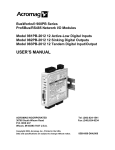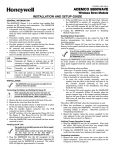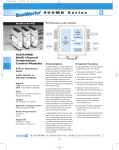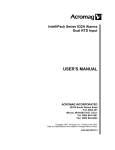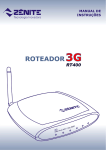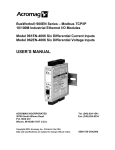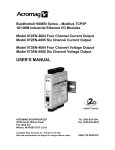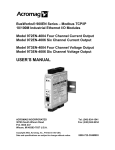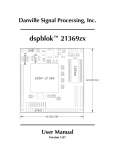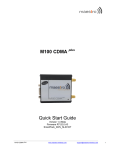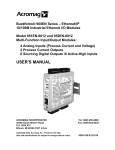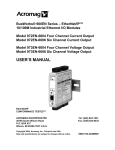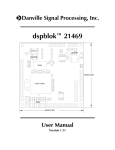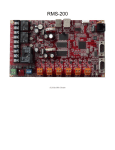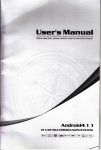Download BusWorks 900PB Series 966PB User`s Manual
Transcript
BusWorks® 900PB Series ProfiBus/RS485 Network I/O Modules Model 966PB-2004 Four Channel RTD Input Module Model 966PB-2006 Six Channel RTD Input Module USER’S MANUAL ACROMAG INCORPORATED 30765 South Wixom Road P.O. BOX 437 Wixom, MI 48393-7037 U.S.A. Copyright 2002, Acromag, Inc., Printed in the USA. Data and specifications are subject to change without notice. Tel: (248) 624-1541 Fax: (248) 624-9234 8500-695-C04J008 2 BusWorks® 966PB Module User’s Manual ProfiBus RTD Input __________________________________________________________________ TABLE OF CONTENTS Symbols on equipment: ! Means Refer to User’s Manual (this manual) for additional information”. The information of this manual may change without notice. Acromag makes no warranty of any kind with regard to this material, including, but not limited to, the implied warranties of merchantability and fitness for a particular purpose. Further, Acromag assumes no responsibility for any errors that may appear in this manual and makes no commitment to update, or keep current, the information contained in this manual. No part of this manual may be copied or reproduced in any form without the prior written consent of Acromag, Inc. IMPORTANT SAFETY CONSIDERATIONS You must consider the possible negative effects of power, wiring, component, sensor, or software failure in the design of any type of control or monitoring system. This is very important where property loss or human life is involved. It is important that you perform satisfactory overall system design and it is agreed between you and Acromag, that this is your responsibility. GETTING STARTED MOUNTING AND DIMENSIONS……………………… CONTROLS & INDICATORS..………………………… ISOLATION BARRIERS..………………………………. SETTING SLAVE ADDRESS………………………….. CONNECTIONS…………………………………………. DIN-Rail Mounting And Removal……………… Network…………………………………………….. Power……………………………………………….. Analog Inputs……..………………………………. Earth Ground..…………………………………….. TROUBLESHOOTING………………………………….. Tips For Building ProfiBus Networks..………. Top Four Common ProfiBus Problems………. Troubleshooting Tools………………………….. Using Connectors To Troubleshoot………….. Diagnostics Function……………………………. Diagnostics Table………………………………… CALIBRATION…………………………………………... 3 3 3 4 4 4 5 6 7 7 8 8 8 8 9 9 10 11 TECHNICAL REFERENCE KEY FEATURES………………………………………… HOW IT WORKS………….…………………………….. SPECIFICATIONS………………………………………. Model Numbers………………………………….. Analog Inputs..………………....………………… General Specifications………………………….. Enclosure/Physical………………………………. Agency Approvals…..……………………………. Environmental…………………………………….. Communication Interface……………………….. Controls & Indicators……………………………. Module Specific Parameters…………………… Data Types………………………………………… 12 13 14 14 14 15 15 16 16 17 19 19 20 Windows® is a registered trademark of Microsoft Corporation. Profibus® is a registered trademark of ProfiBus Trade Organization. All trademarks are the property of their respective owners. _______________________________________________________________________________________ Acromag, Inc. Tel:248-624-1541 Fax:248-624-9234 Email:[email protected] http://www.acromag.com BusWorks® 966PB Module User’s Manual ProfiBus RTD Input ___________________________________________________________________ Rubber Plug - Pull To Remove For Switch Access (TB4 connections are present for Model 966PB-2006 only) TB4 TB3 DC- DC+ Unit mounts to “T” type DIN rails (35mm, type EN50022). PWR 11 12 13 14 15 16 IN3- IN2- WARNING: IEC Safety Standards may require that this device be mounted within an approved metal enclosure or sub-system, particularly for applications with exposure to voltages greater than or equal to 75VDC or 50VAC. IN3L IN3+ IN2+ TB2 IN1- IN1+ IN1L IN0- IN0+ IN0L TB1 2.34 (59.4) RTD INPUTS 2,3 21 22 23 24 25 26 TB2 TB1 3.90 (99.1) "T" RAIL DIN MOUNTING DIN EN 50022, 35mm 4.35 (110.5) NOTE: Dimensions Are INCHES (MILLIMETERS). MODEL 966PB-2006 ENCLOSURE DIMENSIONS REMOVE PLUG TO ACCESS DP SLAVE ADDRESS SWITCHES (TB4 connections are present for Model 966PB-2006 only) TB4 TB3 CONTROLS & INDICATORS DC- DC+ SLAVE ADDRESS (HEX) RTD INPUTS 4,5 (966PB-2006 ONLY) LRTN LSD MSD 33 32 31 TB4 IN4- IN4+ IN5- IN5L IN4L 46 45 44 43 42 41 TB3 RUN/PWR LED (GREEN) BUS STATUS LED (YELLOW) BUS IN5+ Acromag RUN MOUNTING AND DIMENSIONS Units may be mounted sideby-side on 1-inch centers. RTD INPUTS 0,1 1.05 (26.7) LRTN IN4- IN4+ IN4L IN5- IN5L RTD INPUTS 4,5 (966PB-2006 ONLY) IN2L PROFIBUS LSD MSD 33 32 31 SLAVE ADDRESS (HEX) 3.75 (95.3) CL IN5+ 46 45 44 43 42 41 BUS 4.68 (118.9) RUN TB3 TB4 Acromag 3 PWR Green Run LED will stay ON if power is on and unit is OK, and will blink if unit fails. PROFIBUS IN3- IN3L IN3+ IN2- IN2+ IN2L TB2 IN1- IN1L IN1+ IN0L IN0- 11 12 13 14 15 16 21 22 23 24 25 26 TB2 TB1 963/964PB ISOLATION DIAGRAM Yellow BUS LED will turn ON if module is properly connected to the network and in data exchange mode. RTD INPUTS 2,3 ANALOG INPUTS PWR TB4 RTD INPUTS 4,5 (966PB-2006 ONLY) DC+ DC- LSD MSD 33 32 31 SLAVE ADDRESS (HEX) PWR IN3L IN3- IN3+ IN2L IN2- IN2+ TB2 IN1- RTD INPUTS 2,3 IN1L IN1+ IN0L IN0- IN0+ RTD INPUTS 0,1 TB1 Dashed Lines denote isolation barriers. The input circuit, network, and power circuits are isolated from each other for safety and noise immunity. 5V 5V NETWORK ISOLATION BARRIERS TRANSFORMER OPTICAL 11 12 13 14 15 16 TB3 TB3 LRTN IN4- IN4+ IN4L IN5+ IN5- IN5L 46 45 44 43 42 41 TB4 REMOVABLE (PLUG-IN TYPE) TERMINAL BLOCKS IN0+ PROFIBUS CONNECTOR DB9 FEMALE TB1 RTD INPUTS 0,1 21 22 23 24 25 26 TB2 TB1 ANALOG INPUTS ANALOG INPUTS _______________________________________________________________________________________ Acromag, Inc. Tel:248-624-1541 Fax:248-624-9234 Email:[email protected] http://www.acromag.com 4 BusWorks® 966PB Module User’s Manual ProfiBus RTD Input __________________________________________________________________ HEX ADDRESS MSD LSD x16 x1 Remove Rubber Plug To Access Address Switches SETTING SLAVE ADDRESS Address is set to 126 (7EH) from the factory. This address is reserved for commissioning purposes only. TOP EDGE VIEW EF 0 1 2 EF 0 1 2 D 3 D 3 4 C 4 C 5 B 5 B A9 76 A9 76 8 8 SET SWITCHES TO A VALID SLAVE ADDRESS FROM 0 TO 125 (00H TO 7DH) Locate hexadecimal address switches in recessed opening next to power terminals (remove rubber plug). 1. Choose a slave address from 0-125 and locate highest MSD number less than this address. Set MSD switch to this number's corresponding HEX digit. MSD x16 HEX LSD DEC x1 HEX 1 Use a screwdriver to rotate these switches to set a unique valid address from 0 to 125. 2 0 0 0 16 32 48 64 80 96 112 128 144 160 176 192 208 224 240 1 2 3 4 5 6 7 8 9 A B C D E F 1 2 3 4 5 6 7 8 9 10 11 12 13 14 15 0 1 2 3 4 5 6 7 8 9 A B C D E F 2. Determine the DECimal remainder and set the LSD switch to its corresponding HEX digit. 3. Replace the rubber plug (if present) over this switch opening to shield circuit from debris. If the switches are set to a valid address from 0-125, then the switch setting determines the slave address and the Set Slave Address software command will be rejected. If these switches are instead set to 126 (7EH) upon powerup (or 126 to 254), the unit will retrieve its address from the internal EEPROM, which is modified via the Set Slave Address command. If these switches are set to 255 (FFH) upon power-up, this will return the address in EEPROM to 126 (7EH). The address stored in the internal EEPROM is modified via the Set Slave Address command. If the address switches are set to 126 (or 126 to 254) upon power-up, the module will retrieve the last address stored within its EEPROM (126 from the factory). With both the internal EEPROM and external switch addresses set to 126, the unit will await the Set Slave Address command after power-up, before proceeding to the parameterization state (address 126 cannot be used in data exchange mode and is reserved for commissioning purpose only). You must use the Set Slave Address command to change the internal (EEPROM) address following power-up in order to proceed. However, if the switches are set to an address less than 126 upon power-up, then the switches determine the slave address and the EEPROM setting is ignored. You can later restore the internal EEPROM setting to 126 by powering the unit up with the address switches set to 255 (FF). You would then power the unit up again with these switches set to 126 in order to place the unit in commissioning mode. CONNECTIONS PUSH MODULE REMOVAL FROM DIN RAIL TB3 DC- LSD MSD 33 32 31 SLAVE ADDRESS (HEX) DC+ 46 45 44 43 42 41 TB4 DIN-Rail Mounting & Removal USE YOUR FINGER TO APPLY DOWNWARD PRESSURE HERE AS YOU LIFT AND TILT MODULE TO REMOVE IT FROM RAIL PWR "T" TYPE DIN RAIL 11 12 13 14 15 16 TB2 TB1 Any Series 9XXPB ProfiBus Module 21 22 23 24 25 26 Remove Terminal Blocks On This Side To Provide Clearance PRY WITH SCREWDRIVER INSERTED IN SLOT HERE (DO NOT TWIST TO AVOID DAMAGING PLASTIC TAB) When attaching the module to the T-type DIN rail, angle the top of the unit towards the rail and locate the top groove of the adapter over the upper lip of the rail. Firmly push the unit towards the rail until it snaps into place. To remove, first separate the input terminal block(s) from the bottom side of the module to create a clearance to the DIN mounting area. Next, while holding the module in place from above, insert a screwdriver into the lower arm of the DIN rail connector and use it as a lever to force the connector down until the unit disengages from the rail (do not twist the screwdriver to avoid damaging plastic). PUSH SCREWDRIVER AS SHOWN TO TILT AND LIFT MODULE OFF RAIL _______________________________________________________________________________________ Acromag, Inc. Tel:248-624-1541 Fax:248-624-9234 Email:[email protected] http://www.acromag.com BusWorks® 966PB Module User’s Manual ProfiBus RTD Input ___________________________________________________________________ CONNECTIONS Siemens ProfiBus Connector 9 5 Network 3 8 4 DB9 (Male) 7 2 Grn Insul Shld Green Wire = A Red Wire = B IN OUT Network Do not mix RS485 A & B connections. Green wire is A, red wire is B. You MUST terminate the network at both ends only. Termination resistors are integrated in the ProfiBus connector. When you switch termination ON, the out-going connections are disconnected from the network. RTD INPUTS 4,5 TB3 DC+ DC- SLAVE ADDRESS (HEX) LRTN TB4 IN4- IN4+ IN5- LSD MSD 33 32 31 The connector must have builtin inductors in order to operate at the higher baud rates. 11 12 13 14 15 16 IN3L IN3- IN2+ TB2 IN1- RTD INPUTS 2,3 IN1L IN1+ IN0- IN0+ IN0L RTD INPUTS 0,1 TB1 966PB-2004 ACRO0702.GSD Ident_Number=0702 Hex 966PB-2006 ACRO0701.GSD Ident_Number 0701 Hex ProfiBus Connector ProfiBus Socket (DB9 Female) When building cables, do not mix A & B connections. Green wire is A, Red wire is B. PWR (966PB-2006 ONLY) IN3+ PROFIBUS PVC Sheath Use ProfiBus cable per DIN 19245 and EN 50170. 46 45 44 43 42 41 IN5+ BUS IN4L RUN Always use ProfiBus cable per DIN 19245 and EN 50170. GSD Files: IN5L Acromag DB9 CONNECTIONS 1 Shield 2 No Connection 3 Data A 4 Request To Send 5 Ground 6 +5V 7 No Connection 8 Data B 9 No Connection 0.35 0.30 IN2L ProfiBus Cable (Violet) Red 6 R on off off IN2- on Use ProfiBus connectors similar to the one shown at left (Siemens version shown). Strip Cable Similar to Shown AB 0.25 1 Termination Switch 5 21 22 23 24 25 26 R on off FRONT VIEW ProfiBus Cable IN OUT Green Wire = A Network Red Wire = B RIGHT SIDE VIEW Network Length Use Type A ProfiBus cable per EN 50170. Keep line lengths less than the length indicated below for your transmission rate. For baud rates not shown, the lower length of the closest range end points apply (i.e. 100M at 3Mbps). Bus Segment Length Limit Per Baud Rate For Type A Bus Cable BAUD 9.6K 19.2K 93.75K 187.5K 500K 1.5M 12M Type A 1200M 1200M 1200M 1000M 400M 200M 100M IMPORTANT: Do not connect earth ground to logic Ground (DB9 Pin 5). Earth Ground should connect to cable Shield (common to DB9 Pin 1). Note that Acromag modules also support the optional RTS direction control signal at Pin 4. _______________________________________________________________________________________ Acromag, Inc. Tel:248-624-1541 Fax:248-624-9234 Email:[email protected] http://www.acromag.com 6 BusWorks® 966PB Module User’s Manual ProfiBus RTD Input __________________________________________________________________ CONNECTIONS Termination Network The network must be terminated at both ends only. Most ProfiBus connectors include a switch for termination as shown above. Note that this switch will also disconnect the outgoing network signal. Example ProfiBus System Connections A network segment may contain up to 32 nodes without the use of a signal repeater. Transmission distance is up to 1200 meters per segment without a repeater. Termination must be placed at both ends of a network or network-segment. Acromag RUN Voltage 12VDC 15VDC 24VDC 36VDC Current 217mA 162mA 102mA 69mA PROFIBUS 61 NODE 32' on off 31 Acromag Acromag PROFIBUS PROFIBUS RUN BUS RUN BUS RS485 SIGNAL REPEATER TERMINATION SWITCH on on off NODE 2' off 30 NODE 32 NODE 1' NODE 31 END OF SEGMENT (TERMINATION ON) START OF SEGMENT (TERMINATION ON) END OF NETWORK (TERMINATION ON) on off 4 NODE 5 SEGMENT 2 (UP TO 1200 METERS, UP TO 32 NODES PER SEGMENT) PROFIBUS MASTER PLUG-IN CARD INSTALLED IN PC. NETWORK LENGTH PER BAUD RATE w/ TYPE A PROFIBUS CABLE BAUD 9600bps 19.2Kbps 93.75Kbps 187.5Kbps 500Kbps 1.5Mbps 12Mbps LENGTH 1200M 1200M 1200M 1000M 400M 200M 100M START OF NETWORK (TERMINATION REQD) PROFIBUS MASTER - A HOST PC WITH PROFIBUS CARD INSTALLED AND RUNNING APPLICATION SOFTWARE. Acromag Acromag Acromag PROFIBUS PROFIBUS PROFIBUS RUN BUS RUN on 1 NODE 1 NODE 2 PROFIBUS RS485 NETWORK off BUS RUN on 2 off NODE 3 BUS on 3 off NODE 4 SEGMENT 1 (UP TO 1200 METERS, UP TO 32 NODES PER SEGMENT) NOTE: THE PROFIBUS CONNECTORS SHOWN HAVE A TERMINATION NETWORK BUILT-IN. WITH TERMINATION ON, THE OUTGOING CABLE IS DISCONNECTED FROM NETWORK. SWITCH TERMINATION ON ONLY AT THE BEGINNING AND END OF A NETWORK OR NETWORK SEGMENT. 9 Power The total number of nodes and total distance may be extended by using signal repeater(s). The maximum number of modules possible is further limited by the address range from 0 to 125. Connect 12-36V DC to the power terminals labeled DC+ & DC-. For supply connections, use No. 14 AWG wires rated for at least 75°C. Observe proper polarity. CAUTION: Do not exceed 36VDC peak. OBSERVE PROPER POLARITY 12 TO 36VDC EARTH GROUND TB3 TB3 DC+ DC- PWR TIP: A recommended RS485 repeater for ProfiBus is the Siemens 6ES79720AA010XA0. PROFIBUS BUS INPUT POWER IS ISOLATED LRTN SLAVE ADDRESS (HEX) Note: 12Mbps installations require a minimum cable length of 1M between stations. RUN LSD MSD 33 32 31 Up to 125 slave modules may network together with a class 1 master using four repeaters (one repeater every 31 nodes). Address 0 is typically reserved for the class 1 master. Acromag BUS Note that earth ground is connected to the LRTN terminal as shown above and is not connected to the inputs. CAUTION: Risk of Electric Shock – More than one disconnect switch may be required to de-energize equipment before servicing. IMPORTANT – External Fuse: If unit is powered from a supply capable of delivering more than 1A to the unit, it is recommended that this current be limited via a high surge tolerant fuse rated for a maximum current of 1A or less (for example, see Bel Fuse MJS1). _______________________________________________________________________________________ Acromag, Inc. Tel:248-624-1541 Fax:248-624-9234 Email:[email protected] http://www.acromag.com 7 BusWorks® 966PB Module User’s Manual ProfiBus RTD Input ___________________________________________________________________ IN0L IN1+ IN1IN1L TB1 EARTH GROUND NOTE 1 DO NOT GROUND TB1 TB1 IN0+ IN0IN0L IN1+ IN1IN1L Input is Cu, Pt, or Ni RTD, or resistance, connected in 2wire, or 3-wire fashion. RTD INPUTS 0,1 IN0- 16 15 14 13 12 11 EARTH GROUND TB1 IN0+ RTD INPUTS 0,1 16 15 14 13 12 11 NOTE 1 Inputs are not isolated channel-to-channel. JUMPER [IN-] TO [INL] FOR 2-WIRE RTD NOTE 1: DO NOT APPLY EARTH GROUND TO INPUT LEADS OR INPUT TERMINALS. EARTH GROUND SHOULD INSTEAD BE APPLIED AT THE INPUT LOGIC GROUND TERMINAL (LRTN AT TB3-33). Unused inputs should be terminated and not left floating. IMPORTANT: RTD INPUTS ARE NOT ISOLATED CHANNEL TO CHANNEL For 2-wire connections, be sure to jumper the IN- and INL leads together. JUMP JUMPER [IN-] TO [INL] FOR RESISTANCE BOX OR 2-WIRE TB1 IN0+ IN0IN0L IN1+ IN1IN1L RTD INPUTS 0,1 16 15 14 13 12 11 RESISTANCE DECADE BOX TERMINATE UNUSED INPUT CHANNELS R TB1 TB1 R TB1 IN0+ IN0IN0L IN1+ IN1IN1L RTD INPUTS 0,1 UNUSED INPUTS RESISTANCE INPUT 16 15 14 13 12 11 DO NOT GROUND Analog Inputs 2-WIRE RTD 3-WIRE RTD 9 CONNECTIONS Connect analog input signals to the input terminals as shown below according to your signal type. Note earth ground. JUMP 9 Do not attach earth ground to any input leads. Earth ground should connect to the LRTN terminal at TB3-33. DO NOT LEAVE UNUSED INPUTS FLOATING Earth Ground Connect Earth Ground as shown in the connection drawings above. Note that earth ground is connected to the LRTN terminal and should not connect to the inputs. Additionally, ground the ProfiBus cable as shown in the drawing below. The ground connections noted are recommended for best results. If sensors are already grounded, use caution and avoid making additional ground connections which could create ground loops. Warning: To comply with safety and performance standards, use shielded cable and connect earth ground as noted. Failure to use good wiring and grounding practices may be unsafe and hurt performance. The plastic module housing does not require earth ground. PROFIBUS WIRING AND GROUND PROFIBUS CONNECTOR 1. Always connect the cable shield to earth ground at both ends as shown. 2. If the field device does not include an earth ground screw, it may be necessary to strip the cable insulation near the field device and clamp the cable shield to a local grounding bar or surface as shown. EARTH GROUND SCREW ON EQUIPMENT (WHEN AVAILABLE) THE SHIELD IS COMMON TO THE HOUSING (FOR METAL ENCLOSURES). PROFIBUS FIELD DEVICE R on off OUT GROUND CLAMP ACROMAG MODULES: The metal shroud of the DB9 ProfiBus connector on Acromag modules is common to pin 1 of the DB9 connector (SHIELD). This is also common to the cable shield which must be earth grounded. Acromag modules are enclosed in plastic and do not provide a dedicated earth ground screw. As such, a local earth ground connection to the cable shield must be made as shown above. R on off CABLE SHIELD EARTH GROUND SCREW ON EQUIPMENT (WHEN AVAILABLE) INP NOTE: If a potential difference exists between earth grounding points, an equalization current can flow through the cable shield when connected at both ends. In this case, it may be necessary to install an additional potential equalization line between field locations to minimize this current as shown here. CABLE SHIELD EQUIPOTENTIAL BONDING STRIP (IF NECESSARY--SEE NOTE) PROFIBUS CABLE GROUND CLAMP THE SHIELD IS COMMON TO THE HOUSING (FOR METAL ENCLOSURES). Use ProfiBus cable per DIN 19245 and EN 50170. Use only approved cables with braided shields of density greater than 80%. Green Wire = A Red Wire = B AB Grn PROFIBUS FIELD DEVICE Shld Red GROUNDING: Insul PROFIBUS CONNECTOR PVC Sheath _______________________________________________________________________________________ Acromag, Inc. Tel:248-624-1541 Fax:248-624-9234 Email:[email protected] http://www.acromag.com 8 BusWorks® 966PB Module User’s Manual ProfiBus RTD Input __________________________________________________________________ TROUBLESHOOTING Tips For Building ProfiBus Networks The module routinely performs internal diagnostics following power-up or reset. During this period, the green “Run” LED will flash for a moment. If the diagnostics complete OK, the “Run” LED will stop flashing after a few seconds and remain ON. This indicates the unit is operating normally. Once the unit has passed through the initialization, parameterization, and configuration states, and is in data exchange mode, the yellow BUS LED will be ON. If the BUS LED is OFF and the unit is connected to the network, then this is indicative of an initialization problem. • • • • • • • • • • • Top Four Common ProfiBus Problems Troubleshooting Tools Follow the ProfiBus installation guidelines. Use the recommended cable and connectors of the standard. Verify that none of the wires are broken or shorted. Don’t mix up the A & B lines. Green wire is A, red wire is B. Do not exceed the recommended segment length for the baud rate. Make sure that there are no more than 32 RS-485 devices per segment (including the master device and the repeater). Check for proper termination of all copper-wire network segments (an RS-485 segment must have a termination resistor at both ends of the segment only). All activated terminations must be powered all the time. If this is not possible, then consider using an active-termination box. Check whether the station address is set to the correct value. If your network connects between buildings or runs through hazardous environments, consider the use of fiber-optics. Avoid drop lines and keep their length within the specified maximum. If you employ T-drops, consider using repeaters and active-bus terminations. 1. Incorrect slave address set at the slave. 2. ProfiBus connector between the master and slave has its termination switch turned ON. 3. Incorrect module configuration sent to slave. 4. Configuration is based on outdated GSD file information. There are several models of handheld devices on the market that simplify the installation and troubleshooting of ProfiBus networks. The more sophisticated units include LCD displays that read out errors directly. Two of these of these devices are referenced below: Hand-Held ProfiBus Network Maintenance Tools Manufacturer Part Number Special Features Siemens BT 200 Primarily a Cable Tester Comsoft NetTest II Set Includes DP Mono-Master 4000-7-06C-J Functionality In general, these devices can be used to check the network wiring before devices are connected to the bus and are often used to indicate: • • • • Whether the A and B lines have been switched. Whether a short exists between the A & B lines and shield. The occurrence of a wire-break in the A or B line, or shield line. Improper termination. _______________________________________________________________________________________ Acromag, Inc. Tel:248-624-1541 Fax:248-624-9234 Email:[email protected] http://www.acromag.com BusWorks® 966PB Module User’s Manual ProfiBus RTD Input ___________________________________________________________________ These tools can also be used to check the RS-485 interface of a ProfiBus device after it has been connected and may include the following: • • • • The ability to create a list of all stations connected to a network (useful for identifying missing or “offline” devices). Can test individual stations and help identify duplicate addresses. Can measure the distance along a network segment to verify if it complies with the Profibus requirements for distance and data rate. They can detect signal reflections along the network, useful for locating bus line interruptions and discontinuities. 9 TROUBLESHOOTING Troubleshooting Tools Acromag strongly suggests the use of these tools for building and maintaining ProfiBus networks. Note that Profichip also offers a Profibus connector (PA003100) that includes 4 network diagnostic LED’s that may be helpful in trouble-shooting your network (see table below). The standard 9-pin ProfiBus connectors with integrated termination resistors are also helpful in troubleshooting segments of the network. In most of these connectors, when the termination resistors are switched ON, the outgoing portion of the connector is disconnected. As such, you can selectively disable segments of the network until you find the branch that is causing the problem. For example, if your handheld unit is connected to the beginning of a network and indicates a wire break, you can selectively switch off portions of the network and recheck your handheld unit to help pin point the portion of the network that is causing the problem. Below are some ProfiBus connectors that we recommend: Preferred Bus Connectors Manufacturer Part Number Siemens 6ES7972-0BA12-0XA0 Siemens 6ES7972-0BB12-0XA0 Profichip PA003100 Using Connectors To Troubleshoot Special Features Switchable Termination Adds PB Interface (Piggy Back DB9 For Diagnostic Connection) Adds PB Interface and Four Diagnostic LED’s For TroubleShooting. ProfiBus includes a rich diagnostic function that can be used to troubleshoot ProfiBus devices. This function contains 6 bytes of standard diagnostic information, plus up to an additional 238 bytes of device specific diagnostic information. Most configuration tools support this command and can read the diagnostic information from the Profibus device. Diagnostics Function _______________________________________________________________________________________ Acromag, Inc. Tel:248-624-1541 Fax:248-624-9234 Email:[email protected] http://www.acromag.com 10 BusWorks® 966PB Module User’s Manual ProfiBus RTD Input __________________________________________________________________ Diagnostics Table If your problem still exists after checking your wiring and reviewing this information, or if other evidence points to another problem with the unit, an effective and convenient fault diagnosis method is to exchange the module with a known good unit. Acromag’s Application Engineers can provide further technical assistance if required. Complete repair services are also available from Acromag. SYMPTOM Yellow BUS LED does not light. Yellow BUS LED turned OFF. Cannot communicate. POSSIBLE CAUSE Initialization Problem. LED ON if module in data exchange state. Both the internal EEPROM and external address switches are set to an address of 126. Communication Halted. Is power ON at the module and/or RS485 converter? Is address correct? Is the termination switch of the Profibus connector at the prior node turned on? Continuous flashing green RUN LED. Many Communication Errors. Internal firmware problem. Missing Termination Resistors? Is baud rate too high for distance? POSSIBLE FIX Check Station Address. Is GSD file correct. Check for wiring error. Module is awaiting Set Slave Address command in order to complete initialization. Alternately, set switches from 0-125 and re-power. Turn power off and then ON to reset unit. Investigate grounding. Check power. Is green RUN LED ON? Check address settings at the slave. Switch Termination on only at the ends of the network. With termination switch on, the outgoing connections are disconnected from the network chain. Return the module for service. Termination resistors must be placed only at both ends of a network or network segment. Maximum distance is limited below 1200 meters as baud rate is increased above 93.75Kbps (see Table). _______________________________________________________________________________________ Acromag, Inc. Tel:248-624-1541 Fax:248-624-9234 Email:[email protected] http://www.acromag.com BusWorks® 966PB Module User’s Manual ProfiBus RTD Input ___________________________________________________________________ There are six calibration channels for these models. The following table gives the calibration values for supported input ranges. These are the input signals required to calibrate the range endpoints. If calibration is required, it is recommended that all ranges of the unit be done. INPUT RANGE Pt 100Ω (-200 to +850ºC), α=1.3850 Pt 100Ω (-200 to +850ºC), α=1.3911 Ni 120Ω (-80 to +320ºC), α=1.6720 Cu 10Ω (-200 to +260ºC), α=1.4272 0 to 500Ω Linear, α=1.000 Low Calibration 0°C (100Ω) 0°C (100Ω) 0°C (120Ω) 0°C (9.04Ω) 10.00Ω High Calibration 850°C (390.48Ω) 850°C (395.12Ω) 300°C (439.44Ω) 250°C (18.73Ω) 450.00Ω These models have two I/O Configuration definitions in their GSD files, one for normal operation, and another for accomplishing calibration. The normal data exchange definition supports 6 input words (12 input bytes representing your measured values). A second calibration definition supports 6 input words and 6 output words. The master software will allow you to choose which mode the slave will assume—Input Mode or Configuration Mode. The method used to transfer information between the master and slave will vary widely between systems. The steps below represent the minimum steps necessary to accomplish software calibration. If you choose to perform calibration and select Configuration Mode, the master will download the 6I/6O word configuration during the startup sequence, and the module may then be calibrated as follows: 1. With your master software, select the “Configuration Mode” from the GSD file when setting up the master to communicate with the module. 2. With user parameter bytes 0 & 1, set the ranges that are to be calibrated. 3. Apply the zero calibration signal (see table of prior page) to the input to be calibrated and allow the input to settle a few seconds. 4. Write FFH into the low-order byte of the channel’s output word several times (to ensure transmission). In Configuration Mode, the module will automatically calibrate the channel’s zero value when FFH is detected. Then write 00H into the low-order byte to complete zero calibration. 5. Apply the full-scale calibration signal (Cal Hi, see table) to the input to be calibrated and allow the input to settle a few seconds. 6. Write FFH into the high-order byte of the channel’s output word several times to ensure transmission. In Configuration Mode, the module will automatically calibrate the channel’s full-scale value when FFH is detected. Then write 00H into the high-order byte to complete full-scale calibration. 7. Repeat steps 3-6 for the other channels of the same range. 8. With user parameter bytes 0-5, select the next range to be calibrated. 9. Repeat steps 3-7 for all channels of this range. 10. Repeat steps 8-9 until all input ranges have been calibrated. 11. When finished calibrating, use the master software to return the module to the normal “Input Mode” to prevent miscalibration. 11 CALIBRATION IMPORTANT: This module has already been calibrated at the factory and recalibration is not normally required, except as necessary to correct for long term component aging, or to satisfy your company’s maintenance requirements. Do not attempt to recalibrate this module unless absolutely required, as miscalibration will negatively affect the module’s performance. For best results, be sure to use a precision signal source capable of reproducing the nominal endpoint signals shown below, at least as accurate as the module itself (better than ±0.1% of span). Always allow the module to warm up a few minutes prior to calibration. After completing calibration, the module should be reconfigured as required and placed in the normal “Input Mode” configuration (I/O configuration is 6 input words only). In general, your software allows you to select the normal “Input Mode” configuration, and the slave will then be taken off-line by the master and reconfigured. If reconfiguration is successful, the slave module will pass to the data exchange state with a normal I/O configuration. _______________________________________________________________________________________ Acromag, Inc. Tel:248-624-1541 Fax:248-624-9234 Email:[email protected] http://www.acromag.com 12 BusWorks® 966PB Module User’s Manual ProfiBus RTD Input __________________________________________________________________ TECHNICAL REFERENCE KEY FEATURES • • • • • • • • • • • • • • • • • • • • • • PTO Certified - Unit certified by the ProfiBus Trade Organization. Safety Agency Approvals – CE marked, UL, & cUL listed, Class 1; Division 2; Groups A, B, C, D approvals. Fully Independent Slave w/ Direct I/O Connection – This selfcontained unit does not require special bus couplers, power supplies, or a rack mount to operate. Plug-In Terminal Blocks & DIN-Rail Mount - Make mounting, removal, and replacement easy. Barrier strip and spring-clamp type terminals are also available as an option. Industry Standard ASIC – Uses Siemens SPC3 intelligent ASIC to talk ProfiBus. Isolated RS485/ProfiBus Network Interface – Highly immune to noise and can operate over long distances. Allows many modules to network together. Flexible Quad or Hex RTD Inputs - Accepts four or six channels of input for Platinum (Pt), Copper (Cu), and Nickel (Ni) RTD types, or simple resistance. RTD’s are connected in 2 or 3 wire fashion. Linearization, excitation, lead break detection, and lead-wire compensation (3-wire) are included. Ratiometric Differential RTD Sampling – The RTD is sampled differentially using ratiometric conversion and this increases accuracy. Automatic Self-Calibration – Built-in self-calibration helps correct for temperature drift of the input circuit every 60 seconds. Upscale Or Downscale Break Detection – Inputs may be configured to go upscale or downscale upon lead breakage. Auto-Baud Rate Detection – The baud rate is set automatically. High-Speed Data Rates – Half-duplex RS485 up to 12M baud. Includes RTS Support – ProfiBus interface includes the optional RTS (Request-To-Send) direction control. Precise High-Resolution A/D Conversion – Modules use highresolution, low noise, sigma-delta analog-to-digital conversion for high accuracy and reliability. Nonvolatile Reprogrammable Memory – Allows the functionality of this device to be reliably reprogrammed thousands of times. Fully Isolated – Input channels (as a group), network, and power are all isolated from each other for safety and increased noise immunity. LED Indicators – A green LED indicates power. A yellow bus LED indicates proper network connection and unit in data exchange mode. Watchdog Timer Built-In – Standard for the ASIC and operates in the data exchange mode if communication with the master is lost. Self-Diagnostics & Diagnostic Watchdog - For easy maintenance and troubleshooting. Includes a hardware watchdog timer built into the microcontroller that causes it to initiate a self reset if the controller ever “locks up” or fails to return from an operation in a timely manner. Wide-Range DC-Power - Diode-coupled power provides reverse polarity protection and may be used with redundant supplies, and/or battery back-up. Hardened For Harsh Environments - For protection from RFI, EMI, ESD, EFT, & surges. Has low radiated emissions per CE requirements. Wide Ambient Operation – Reliable over a wide temperature range. _______________________________________________________________________________________ Acromag, Inc. Tel:248-624-1541 Fax:248-624-9234 Email:[email protected] http://www.acromag.com BusWorks® 966PB Module User’s Manual ProfiBus RTD Input ___________________________________________________________________ These input modules will process up to four or six RTD input signals, according to model number, and provide an isolated RS485 ProfiBus interface for configuring and monitoring the inputs. One A/D is provided for every pair of input channels and each input drives a separate A/D channel. An integrated multiplexer and analog switch are used to connect each of two A/D input channels to the A/D converter. The A/D converter then applies appropriate gain to these signals, performs analog-to-digital conversion, and digitally filters the signals. The digitized A/D signal is then transmitted serially to a microcontroller. The microcontroller completes the transfer function according to the input type/range per its embedded program. Configuration and calibration parameters are stored in non-volatile memory integrated within the microcontroller. These modules implement the ProfiBus protocol via an industry-standard SPC3 ASIC from Siemens. This ASIC acts like a RAM or UART chip to the internal microcontroller and completely handles the requirements of the protocol standard. The ASIC will transfer network data to the microcontroller and automatically provide the response to the bus. The ASIC handles the ProfiBus protocol and communicates with the network via an optically isolated RS485 transceiver. A wide input switching regulator (isolated flyback) provides isolated power to the input circuit and the RS485 port. Refer to the simplified schematic below to gain a better understanding of the circuit. HOW IT WORKS 966PB SIMPLIFIED SCHEMATIC 1+ ISOLATED RS485 1R+ A/D #1 PWR LED BUS LED +5V +5V RTS 22+ PROFIBUS SPC3 SLAVE ASIC MICRO CONTROLLER 1+ 1R+ 13 A/D #2 RS485 PROFIBUS TRANSCEIVER 4 DB9 SHLD 4 2- N E T W O R K ADDRESS BUFFER 2+ EF 0 1 2 3 D C 4 5 B A9 76 8 EF 0 1 2 3 D 4 C B 5 A9 7 6 8 1+ ISOLATED INPUT POWER 1R+ 2- A/D #3 12-36VDC ISOLATED SECONDARIES NETWORK POWER 5V 2+ ISOLATED FLYBACK SWITCHER DC+ DC- 5V LRTN 100 INPUT/LOGIC POWER EARTH GROUND _______________________________________________________________________________________ Acromag, Inc. Tel:248-624-1541 Fax:248-624-9234 Email:[email protected] http://www.acromag.com P O W E R 14 BusWorks® 966PB Module User’s Manual ProfiBus RTD Input __________________________________________________________________ SPECIFICATIONS These DC-powered, DIN-rail mount, ProfiBus DP slave modules will condition up to four or six RTD input signals according to the model, and provide an isolated RS485/ProfiBus network interface. Inputs (as a group), network, and power are isolated from each other. Non-volatile reprogrammable memory in the module stores configuration and calibration information. Model Numbers 966PB-2004 (4 Ch RTD) 966PB-2006 (6 Ch RTD) The ProfiBus model prefix “900” denotes the Series 900. The “PB” suffix denotes ProfiBus. Select 966PB for RTD inputs. The four digit suffix of this model number represents the following options, respectively: “2” = ProfiBus DP; “0” = Default; “04” or “06” = 4 or 6 Channels, respectively. Analog Inputs Four or six RTD input channels according to model number. The unit must be wired and configured for the intended input type and range (see Connections Section for details). The following paragraphs summarize this model’s input types, ranges, and other applicable specifications. RTD: User configured to one of four RTD types, or as a simple resistance input as noted in Table 1 of the following page. The module supports 2 or 3-wire connection types and provides sensor excitation, linearization, lead-wire compensation (3-wire mode), and sensor lead break detection. Input Reference Test Conditions (Unless Otherwise Noted): Pt RTD 0°C to 100°C, Ni RTD 0°C to 50°C, Cu RTD 0°C to 250°C; Ambient = 25°C; Power = 24VDC. Input Configuration: Two-wire or three-wire only. Excitation Current: 1mA DC typical, all types. Linearization: Better than ±0.25°C, typical. Lead-Wire Compensation: Applies to 3-wire RTD with lead wires of equal size and length. The maximum possible resistance including lead wires is 506Ω. Thus, the maximum lead resistance is approximately 25Ω per lead (Pt), 15Ω per lead (Ni), 10Ω per lead (Cu), 3Ω per lead (500Ω resistance). Lead Resistance Effect: 3.5°C per Ω of unbalance typical for Pt, 1.4°C per Ω of unbalance typical for Ni, 25.5°C per Ω of unbalance typical for Cu. Break Detection: Sensor failure (open) or lead breakage can provide upscale or downscale indication for all channels. This applies to faults with individual leads, or all leads together. IMPORTANT (0-500 ohm inputs w/ break detection): The maximum input resistance including lead wires is about 506Ω. If break detection is set downscale and your input resistance is greater than 506Ω (saturated), this will trigger break detection and the input reading will be sent downscale for the over-range input resistance, without actual lead breakage. Likewise, upscale break is indistinguishable from an overrange input resistance greater than 506Ω. _______________________________________________________________________________________ Acromag, Inc. Tel:248-624-1541 Fax:248-624-9234 Email:[email protected] http://www.acromag.com BusWorks® 966PB Module User’s Manual ProfiBus RTD Input ___________________________________________________________________ 15 Table 1: Supported RTD Types, Ranges, and Accuracy α °C Range RTD Type Typical Accuracy alpha 1.3850 -200 to +850°C Pt 100Ω ±0.25°C 1.3911 -200 to +850°C Pt 100Ω ±0.25°C 1.6720 - 80 to +320°C Ni 120Ω ±0.25°C 1.4272 -200 to +260°C Cu 10Ω ±1.25°C Resistance (Linear) 1.000 0 to 500Ω ±0.05Ω Note (Table 2): Alpha (α) is used to identify the particular RTD curve. The value of alpha is derived by dividing the resistance of the sensor at 100°C by the resistance at 0°C (α = R100°C/R0°C). For Pt 100Ω, this is 138.5Ω/100.0Ω, or 1.385 (also shown as 0.00385Ω/Ω/°C). Accuracy: Accuracy is better than ±0.1% of span, typical for nominal input ranges. This includes the effects of repeatability, terminal point conformity, and linearization, but does not include sensor error. Measurement Temperature Drift: Better than ±50ppm/°C (±0.005%/°C). Analog to Digital Converter (A/D): A 16-bit Σ-∆ converter, Analog Devices AD7714YRU. A/D reference is 1020Ω (1.02V at 1mA excitation). The differential input is sampled ratiometric to the reference. Input Bias Current: 1mA DC excitation current. Resolution: 0.005% or 1 part in 20000 (see Table 2 below). General Specifications Table 2: Effective Resolution Per Applicable Range Range Resolution 10Ω Cu (α=1.4272) 0.2°C (0.36°F) Pt (α=1.3850) 0.1°C (0.18°F) Pt (α=1.3911) 0.1°C (0.18°F) Ni (α=1.6720) 0.1°C (0.18°F) 0 to 500Ω 7.8125mΩ Input Conversion Rate: 80ms per channel, or 480ms for all six input channels. Input Filter: Normal mode filtering, plus digital filtering optimized and fixed per input range within the Σ-∆ ADC. Input Filter Bandwidth: -3dB at 3Hz, typical. Noise Rejection (Normal Mode): Better than 40dB @ 60Hz, typical with 100Ω input unbalance. Noise Rejection (Common Mode): Better than 130dB @ 60Hz, typical with 100Ω input unbalance (10Ω unbalance for Cu RTD). Dimensions: 1.05 inches wide, 4.68 inches tall, 4.35 inches deep. Refer to the dimensions drawing at the front of this manual. DIN Rail Mount: Type EN50022; “T” rail (35mm). I/O Connectors: Removable plug-in type terminal blocks rated for 15A/300V; AWG #12-24 stranded or solid copper wire. Network Connector: 9-pin D-Sub connector (female) with metal housing and 4-40 jack screw support. Enclosure and Physical _______________________________________________________________________________________ Acromag, Inc. Tel:248-624-1541 Fax:248-624-9234 Email:[email protected] http://www.acromag.com 16 BusWorks® 966PB Module User’s Manual ProfiBus RTD Input __________________________________________________________________ Enclosure and Physical D-Sub Pin Signal Description 1 SHLD Shield (Connect to Earth Ground) 2 NC No Connection 3 A Data A (TxD/RxD+) 4 RTS Request To Send 5 GND RS485 Logic Ground 6 +5V +5V 7 NC No Connection 8 B Data B (TxD/RxD-) 9 NC No Connection Note: SHLD pin 1 connects to the DB9 connector shroud which connects to the cable shield which is earth grounded. Case Material: Self-extinguishing NYLON type 6.6 polyamide thermoplastic UL94 V-2, color beige; general purpose NEMA Type 1 enclosure. Printed Circuit Boards: Military grade FR-4 epoxy glass. Shipping Weight: 1 pound (0.45 Kg) packed. Agency Approvals ProfiBus Trade Organization (PTO): Certified. Safety Approvals: CE marked (EMC Directive 89/336/EEC); UL Listed (UL508, UL1604); cUL Listed (Canada Standard C22.2, No. 142M1987 & 213-M1987); Hazardous Locations: Class 1; Division 2; Groups A, B, C, and D. Environmental Operating Temperature: -25°C to +70°C (-13°F to +158°F). Storage Temperature: -40°C to +85°C (-40°F to +185°F). Relative Humidity: 5 to 95%, non-condensing. Power Requirements: 11-36V DC SELV (Safety Extra Low Voltage). Observe proper polarity. Current draw will decrease up to 13% as the baud rate is increased to 12MB. Data below is at 9600 baud. CAUTION: Do not exceed 36VDC peak, to avoid damage to the module. External Fuse: Select a high surge tolerant fuse rated for 1A or less to protect unit. Supply 12V 15V 24V 36V 966PB-2004 Current (Typical/Maximum) 189mA/208mA Max 142mA/157mA Max 87mA/96mA Max 62mA/69mA Max 966PB-2006 Current (Typical/Maximum) 197mA/217mA Max 147mA/162mA Max 92mA/102mA Max 62mA/69mA Max CAUTION: Risk of Electric Shock – More than one disconnect switch may be required to de-energize equipment before servicing. Note that input channels are not isolated channel-tochannel. Power Supply Effect: Volts: Less than ±0.001% of output span change per volt for rated power supply variations. 60/120 Hz Ripple: Less than 0.01% of output span per volt peak-topeak of power supply ripple. Isolation: Input channels (as a group), power, and network circuits are isolated from each other for common-mode voltages up to 250VAC, or 354V DC off DC power ground, on a continuous basis (will withstand 1500VAC dielectric strength test for one minute without breakdown). Complies with test requirements of ANSI/ISA-82.01-1988 for voltage rating specified. _______________________________________________________________________________________ Acromag, Inc. Tel:248-624-1541 Fax:248-624-9234 Email:[email protected] http://www.acromag.com BusWorks® 966PB Module User’s Manual ProfiBus RTD Input ___________________________________________________________________ Installation Category: Designed to operate in an Installation in a Pollution Degree 2 environment with an installation category (Overvoltage Category) II rating. Electromagnetic Interference Immunity (EMI): Measurement shift has been demonstrated at less than ±2.5% of a 100°C reference span for interference from switching solenoids, commutator motors, and drill motors. Electromagnetic Compatibility (EMC) Minimum Immunity Per European Norm EN50082-1: Electrostatic Discharge (ESD) Immunity: 4KV direct contact and 8KV air-discharge to the enclosure port per EN61000-4-2. Radiated Field Immunity (RFI): 10V/M, 80 to 1000MHz AM and 900MHz keyed carrier, per EN61000-4-3 and ENV50204. Electrical Fast Transient Immunity (EFT): 2KV to power, and 1KV to signal I/O per EN61000-4-4. Conducted RF Immunity (CRFI): 10V rms, 150KHz to 80MHz, per EN61000-4-6. Surge Immunity: 1KV per EN61000-4-5. Emissions Per European Norm EN50081-1: Radiated Frequency Emissions: 30 to 1000MHz per EN55022 Class A WARNING: This is a Class A product. In a domestic environment, this product may cause radio interference in which the user may be required to take adequate measures. 17 Environmental These limits represent the minimum requirements of the standard, but product has typically been tested to comply with higher standards in some cases. IMPORTANT: Power, input, and output (I/O) wiring must be in accordance with Class I, Division 2 wiring methods Article 501-4(b) of the National Electrical Code, NFPA 70 for installations in the U.S., or as specified in section 18-1J2 of the Canadian Electrical Code for installations within Canada and in accordance with the authority having jurisdiction. This equipment is suitable for use in Class I, Division 2, Groups A, B, C, and D, or non-hazardous locations only. WARNING – EXPLOSION HAZARD – Substitution of components may impair suitability for Class I, Division 2. WARNING – EXPLOSION HAZARD – Do not disconnect equipment unless power has been switched off or the area is known to be non-hazardous. Interface Standard: 3-wire RS-485 multi-drop, half-duplex (D, D-bar, and Common), asynchronous. Command/Response Protocol: Standard ProfiBus DP (Master/Slave) protocol per European Norm EN50170. Baud Rate: Supported baud rates are 9600, 19.2K, 45.45K, 93.75K, 187.5K, 500K, 1.5M, 3M, 6M, and 12M bits per second, auto-detected. Maximum transmission length is dependent on baud rate selection (range is up to 1200M at 9600bps, or up to 100M at 12Mbps). Refer to the following table for maximum transmission distances at supported baud rates using recommended type A (<30pF/M), or alternately type B (<60pF/M) bus wire (see EN50170): Communication Interface _______________________________________________________________________________________ Acromag, Inc. Tel:248-624-1541 Fax:248-624-9234 Email:[email protected] http://www.acromag.com 18 BusWorks® 966PB Module User’s Manual ProfiBus RTD Input __________________________________________________________________ Communication Interface Baud Rate 9600 bps 19.2K bps ≤ 93.75K bps 187.5K bps 500K bps 1.5M bps ≤ 12M bps NETWORK LENGTH Type A Type B 1200M 1200M 1200M 1200M 1200M 1200M 1000M 600M 400M 200M 200M NA 100M NA Parity: Even parity. Stop Bits: One. Communication Distance: Up to 1200 meters without a repeater. Address: Set via two rotary hexadecimal switches, or alternately via the Set Slave Address command. Remove the rubber plug (if present) adjacent to the power terminals to access these switches. Valid setting is 0-125 (7 bits). Address 126 (7EH) is the default factory address and is reserved for commissioning purposes only. Address 127 (7FH) is reserved by the software as a global address for broadcast messages. If the address switches are set to 126 upon power-up (or 126-254), then the unit will retrieve its address from its internal EEPROM rather than the switches. The internal EEPROM setting is modified via the Set Slave Address command. Powering up with switches set to 255 (FFH) will cause the internal EEPROM setting to revert back to 126 (7EH), which may be used to recommission the module. If both the internal EEPROM address and the switches are set to 126 upon power-up (this is the initial state from the factory), the module will await the Set Slave Address command before completing initialization and assuming the data exchange mode. IMPORTANT (Address Setting): The internal EEPROM address setting and external switch setting is 126 from the factory. As such, the module will await the Set Slave Address command following power-up and will not proceed to exchange data, unless the external switches are instead set to an address from 0-125, or the internal setting is changed to an address from 0-125 via the Set Slave Address command. Maximum Message Size: Up to 32 bytes recommended, extendable up to 244 bytes of data/node/message, plus 11 bytes of overhead (data frame). ProfiBus Character: 11 bits (1 start bit + 8 data bits + 1 even parity bit + 1 stop bit). Applies to all bytes, including frame bytes. Ident_Number: 0702 Hex (966PB-2004); 0701 Hex (966PB-2006). GSD File: ACRO0702.GSD (966PB-2004); ACRO0701.GSD (966PB2006). Bus Idle State: “1” (a start bit causes line to go to “0”). An idle state of at least 33 Tbits (sync-time) must be provided between messages. Note: 1Tbit at 12Mbaud = 1/12000000bit/sec = 83nsec. Network Capacity: Multi-drop up to 31 modules, plus a host, without a repeater. Up to 125 modules plus a host if four repeaters are used (one for every 31 nodes). Network Termination: Use 220Ω “A” to “B”, plus 390Ω “A” to GND, and 390Ω “B” to +5V. Use ±2%, 0.25W resistors. _______________________________________________________________________________________ Acromag, Inc. Tel:248-624-1541 Fax:248-624-9234 Email:[email protected] http://www.acromag.com BusWorks® 966PB Module User’s Manual ProfiBus RTD Input ___________________________________________________________________ 19 LED Indicators: Run (Green) - Constant ON indicates power is applied and unit is OK. Flashing ON/OFF indicates unit is performing diagnostics (first few seconds following power-up), or has failed diagnostics (after a few seconds). Bus (Yellow) – ON indicates unit has completed its initialization sequence and is in the data exchange mode on the network. Switches: Slave Address – Slave address is set via two rotary hexadecimal switches adjacent to the power terminals (remove rubber plug if present to access these switches, see Address above). Controls & Indicators This model includes 5 user parameterization bytes (User_Prm_Data) defined as follows: Module Specific Parameters (User_Prm_Data) Byte 0 1 2 3 4 5 6 Description Do Not Use – Reserved for SPC3 ASIC. Channel 0 & 1 Range Select: 00H = 3-Wire Pt (α=1.3850) 01H = 3-Wire Pt (α=1.3911) 02H = 3-Wire Ni (α=1.6720) 03H = 3-Wire 10Ω Cu (α=1.4272) 04H = 3-Wire 0 to 500Ω 05H = 2-Wire Pt (α=1.3850) 06H = 2-Wire Pt (α=1.3911) 07H = 2-Wire Ni (α=1.6720) 08H = 2-Wire 10Ω Cu (α=1.4272) 09H = 2-Wire 0 to 500Ω Channel 2 & 3 Range Select: Same Format as Channel 0 & 1 (See Above) Channel 4 & 5 Range Select: Same Format as Channel 0 & 1 (See Above) Break Detection: 00H = Upscale (all channels). 01H = Downscale (all channels). Writing 55H to this register will cause the module to restore its original factory calibration. Note that 55H is not stored, but acts as a trigger, as this byte always reads as 00H. Factory Use Only – Do Not Modify. Default NA 00H 00H 00H 00H 00H 00H Note that channels share the same break detect configuration, but the input range may vary between channel pairs. All parameterization bytes take effect immediately. This model does not include any user defined diagnostic data (Ext_Diag_Data). _______________________________________________________________________________________ Acromag, Inc. Tel:248-624-1541 Fax:248-624-9234 Email:[email protected] http://www.acromag.com 20 BusWorks® 966PB Module User’s Manual ProfiBus RTD Input __________________________________________________________________ Data Types I/O values of Acromag 9xxPB modules are represented by the following simple data types for temperature, percentage, and discrete on/off. Note that when transferring words (more than 1 byte), the high byte is transmitted first, followed by the low byte (Big-Endian/Motorola format). Data Types Percentage (This model) Temperature (This model) Discrete Description A 16-bit signed integer value with resolution of 0.005%/lsb. ±20000 is used to represent ±100%. For example, -100%, 0% and +100% are represented by decimal values –20000, 0, and 20000, respectively. The full range possible is –163.84% (-32768 decimal) to +163.835% (+32767 decimal). A 16-bit signed integer value with resolution of 0.1°C/lsb. For example, a value of 12059 is equivalent to 1205.9°C, a value of –187 equals –18.7°C. The maximum possible temperature range is –3276.8°C to +3276.7°C. A discrete value is generally indicated by a single bit of an 8-bit byte. The bit number/position typically corresponds to the discrete channel number. Unless otherwise defined for outputs, a 1 bit means the corresponding output is closed or ON, a 0 bit means the output is open or OFF. For active-high inputs, a value of 1 means the input is in its high state (usually >> 0V), while a value of 0 specifies the input is in its low state (near 0V). For active low inputs, a value of 1 means the input is ON (Active low near 0V), while a value of 0 specifies the input is OFF or in its high state (usually >> 0V). Notes: _______________________________________________________________________________________ Acromag, Inc. Tel:248-624-1541 Fax:248-624-9234 Email:[email protected] http://www.acromag.com





















